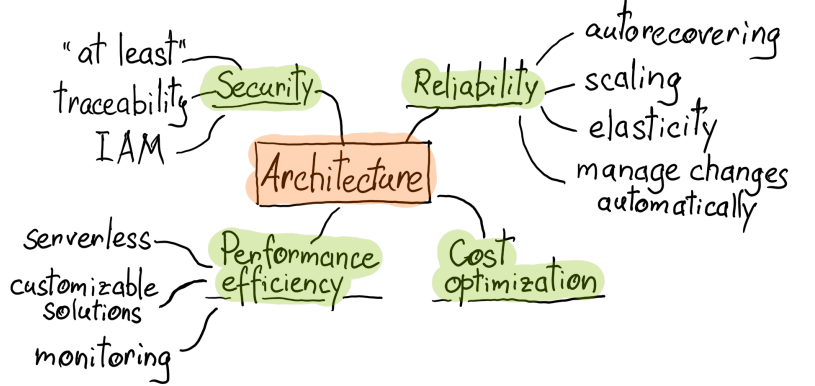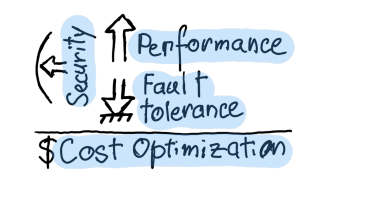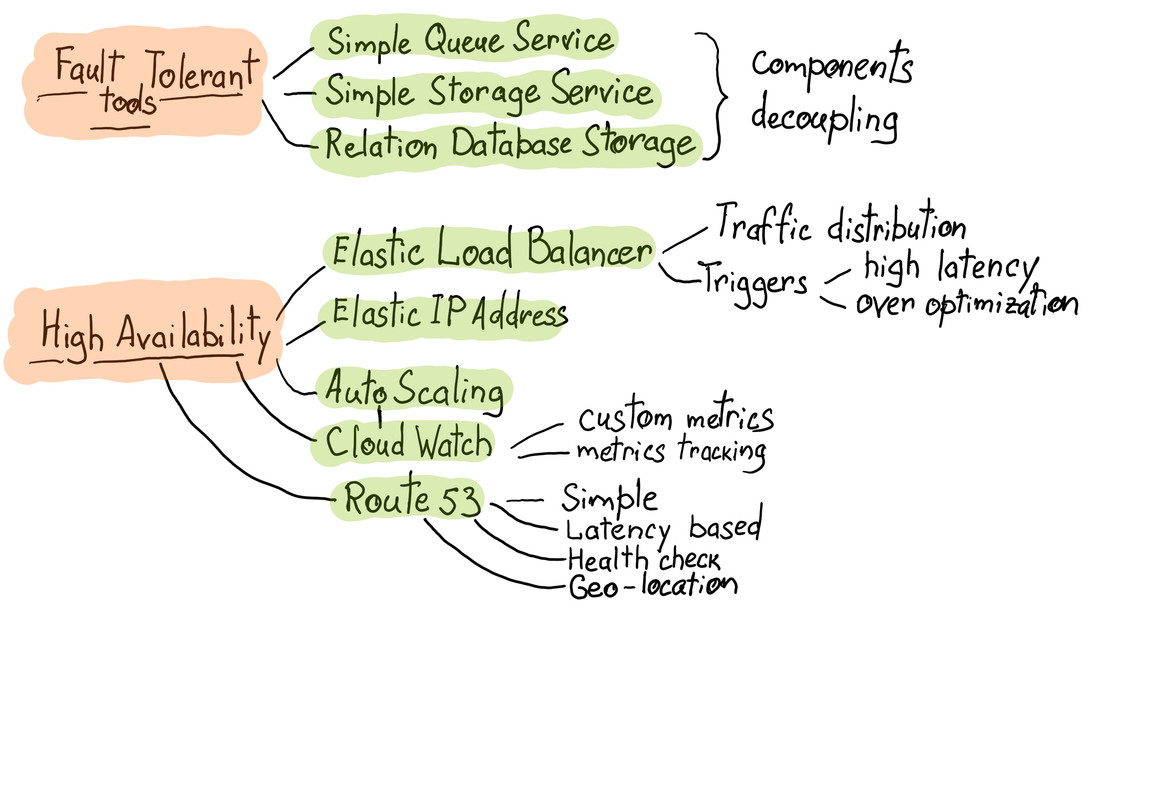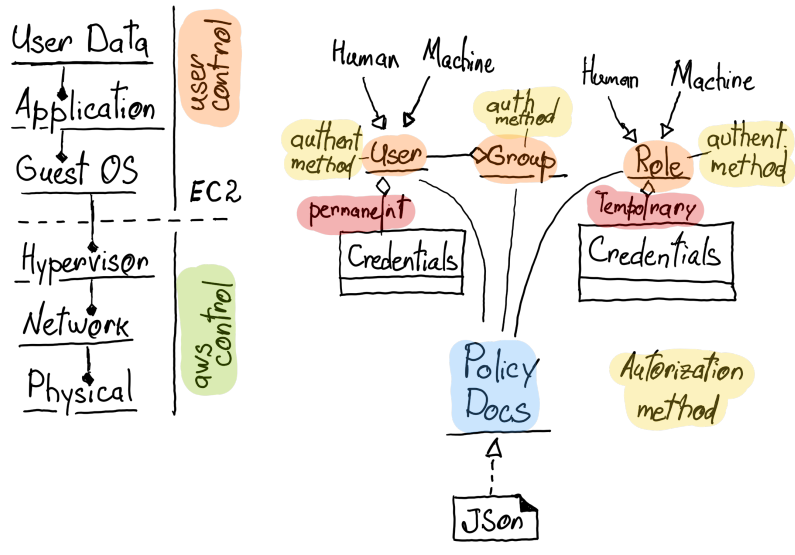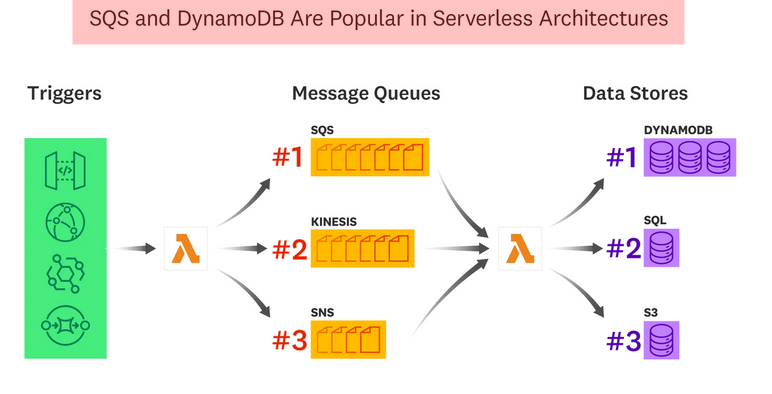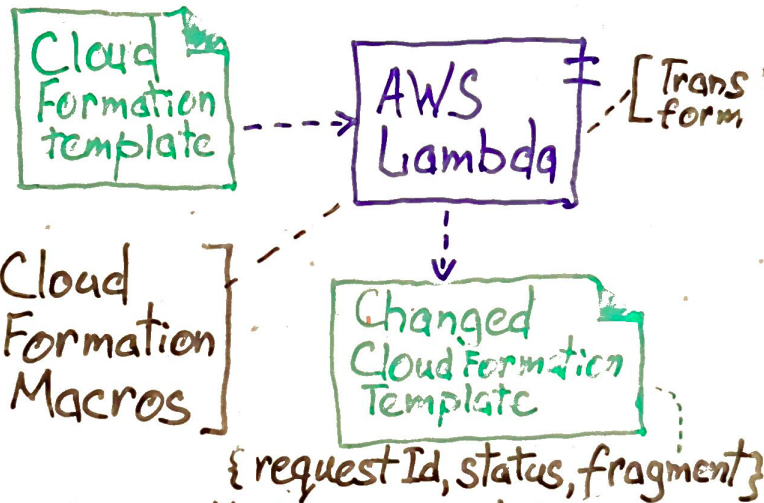- CloudFormation
- CloudCraft
- VisualOps
- draw.io
- official documentation
- whitepapers
- interactive documentation example
- cli ec2
- cli s3
- cli sns
- icons for plantUML
- skill builder
- training materials bookshelf
- workshops aws
- online trainings
- youtube videos
- certification preparation
- labs
- low level commands
- high level commands
- blocking - synchronous
- unblocking - asynchronous
pip search aws-cdk-lib
pip install aws-cdk-libnpm search @aws-cdk
npm install [email protected]aws cli is a python application
# installation
sudo apt install awscli
pip install awscli
# set up user
aws configurationdocker run --rm -it -v $(pwd):/aws public.ecr.aws/aws-cli/aws-cli --version
# share local credentials with docker container
docker run --rm -it -v $(pwd):/aws -v ~/.aws:/root/.aws public.ecr.aws/aws-cli/aws-cli commandpip3 install awscli
# complete -C `locate aws_completer` aws
complete -C aws_completer awsbe aware about precedence:
- Credentials from environment variables have precedence over credentials from the shared credentials and AWS CLI config file.
env variables: https://docs.aws.amazon.com/cli/latest/userguide/cli-configure-envvars.html - Credentials specified in the shared credentials file have precedence over credentials in the AWS CLI config file.
botocore.exceptions.ProfileNotFound: The config profile (cherkavi-user) could not be found
vim ~/.aws/credentials[cherkavi-user]
aws_access_key_id = AKI...
aws_secret_access_key = ur1DxNvEn...
aws_session_token = FwoG....or
aws configure set aws_session_token "Your-value" --profile cherkavi-user
# or
aws configure set cherkavi-user.aws_session_token "Your-value" check configuration: vim ~/.aws/config
using profiling
--region, --output, --profile
aws configure list-profiles
# default profile will be used from env variable AWS_PROFILE
aws s3 ls --profile $AWS_PROFILE# source file_with_credentials.sh
export AWS_REGION=us-east-1
export AWS_ACCESS_KEY_ID=AKIA...
export AWS_SECRET_ACCESS_KEY=SEP6...# aws cli version 2
aws configure set aws_access_key_id <yourAccessKey>
aws configure set aws_secret_access_key <yourSecretKey>
# aws configure set aws_session_token <yourToken>
# aws cli version 1
aws configure set ${AWS_PROFILE}.aws_access_key_id ...
aws configure set ${AWS_PROFILE}.aws_secret_access_key ...
# aws configure set ${AWS_PROFILE}.aws_session_token ...aws configure get aws_access_key_idaws configure sso
# check configuration:
cat ~/.aws/config | grep sso-sessionaws sso login --sso-session $SSO-SESSION_NAME
aws sso login --profile $AWS_PROFILE_DEVor
# aws configure export-credentials --profile RefDataFrame-cicd --format env
eval "$(aws configure export-credentials --profile RefDataFrame-cicd --format env)"aws --debug s3 ls --profile $AWS_PROFILEor put the same in separated file: . /home/projects/current-project/aws.sh
# export HOME_PROJECTS_GITHUB - path to the folder with cloned repos from https://github.com/cherkavi
export AWS_SNS_TOPIC_ARN=arn:aws:sns:eu-central-1:85153298123:gmail-your-name
export AWS_KEY_PAIR=/path/to/file/key-pair.pem
export AWS_PROFILE=aws-user
export AWS_REGION=eu-central-1
# aws default value for region
export AWS_DEFAULT_REGION=eu-central-1
export current_browser="google-chrome" # current_browser=$BROWSER
export aws_service_abbr="sns"
function aws-cli-doc(){
if [[ -z $aws_service_abbr ]]; then
echo 'pls, specify the env var: aws_service_abbr'
return 1
fi
x-www-browser "https://docs.aws.amazon.com/cli/latest/reference/${aws_service_abbr}/index.html" &
}
function aws-faq(){
if [[ -z $aws_service_abbr ]]; then
echo 'pls, specify the env var: aws_service_abbr'
return 1
fi
x-www-browser "https://aws.amazon.com/${aws_service_abbr}/faqs/" &
}
function aws-feature(){
if [[ -z $aws_service_abbr ]]; then
echo 'pls, specify the env var: aws_service_abbr'
return 1
fi
x-www-browser "https://aws.amazon.com/${aws_service_abbr}/features/" &
}
function aws-console(){
if [[ -z $aws_service_abbr ]]; then
echo 'pls, specify the env var: aws_service_abbr'
return 1
fi
x-www-browser "https://console.aws.amazon.com/${aws_service_abbr}/home?region=$AWS_REGION" &
}vim ~/.aws/credentials
aws configure list
# default region will be used from env variable: AWS_REGION
aws configure get region --profile $AWS_PROFILE
aws configure get aws_access_key_id
aws configure get default.aws_access_key_id
aws configure get $AWS_PROFILE.aws_access_key_id
aws configure get $AWS_PROFILE.aws_secret_access_keyexport aws_service_abbr="sns"Resource Based Policy:
- Principal ( User, Group )
- Action
- Resource
- Condition
User is not authorized to perform AccessDeniedException
aws iam list-groups 2>&1 | /home/projects/bash-example/awk-policy-json.sh
# or just copy it
echo "when calling the ListFunctions operation: Use..." | /home/projects/bash-example/awk-policy-json.shtest sandbox for the policy
aws ec2 describe-instances \
--query 'Reservations[*].Instances[*].PublicIpAddress' \
--filters "Name=tag:Project,Values=udacity"aws configservice select-resource-config --expression "SELECT resourceId WHERE resourceType='AWS::EC2::Instance'"price/cost formation: write - free, read - payable
aws_service_abbr="cost-management"
x-www-browser https://${AWS_REGION}.console.aws.amazon.com/cost-management/home?region=${AWS_REGION}#/dashboard
x-www-browser https://${AWS_REGION}.console.aws.amazon.com/billing/home?region=${AWS_REGION}#/budgetsType of the access:
- Temporary - role
- Permanently - user
IAM best practices
relations between entities
aws_service_abbr="iam"
aws-cli-doc
aws-faq
aws-consoleaws iam list-users
# example of adding user to group
aws iam add-user-to-group --group-name s3-full-access --user-name user-s3-bucket
# get role
aws iam list-roles
aws iam get-role --role-name $ROLE_NAME
# policy find by name
POLICY_NAME=AmazonEKSWorkerNodePolicy
aws iam list-policies --query "Policies[?PolicyName=='$POLICY_NAME']"
aws iam list-policies --output text --query 'Policies[?PolicyName == `$POLICY_NAME`].Arn'
# policy get by ARN
aws iam get-policy-version --policy-arn $POLICY_ARN --version-id v1
# policy list
aws iam list-attached-role-policies --role-name $ROLE_NAME
# policy attach
aws iam attach-role-policy --policy-arn $POLICY_ARN --role-name $ROLE_NAMEexample of role with policy creation with awscli
aws_service_abbr="vpc"
aws-cli-doc
aws-faq
aws-consoleexample of creating subnetwork:
VPC: 172.31.0.0
Subnetwork: 172.31.0.0/16, 172.31.0.0/26, 172.31.0.64/26
it is internal tunnel betweeen VPC and the rest of AWS resources
when you are creating target endpoint (to access S3, for instance) and want to use it from ec2, then add also
- SSMMessagesEndpoint
- EC2MessagesEndpoint
public access internet outside access
- create gateway 2 .vpc -> route tables -> add route Security Group
- inbound rules -> source 0.0.0.0/0
- Create Transit Gateway
- Create Transit Gateway attachment
- Create Transit Gateway route table
- Create Transit Gateway route table association
- Create Transit Gateway route table propagation
- Update VPC's route tables
aws_service_abbr='s3'
aws-cli-doc
aws-faq
aws-console- static web site solution
- static web site doc
- static web site endpoints
- alternative solutions for making static website hosting
- Backblaze B2
- DigitalOcean
- Oracle Cloud Infrastructure Object Storage
- IBM Cloud Object Storage
- Alibaba Cloud OSS
- Microsoft Azure Blob Storage
- Google Cloud Storage
# make bucket - create bucket with globally unique name
AWS_BUCKET_NAME="my-bucket-name"
aws s3 mb s3://$AWS_BUCKET_NAME
aws s3 mb s3://$AWS_BUCKET_NAME --region us-east-1
# https://docs.aws.amazon.com/cli/latest/reference/s3api/create-bucket.html
# public access - Block all public access - Off
aws s3api create-bucket --bucket $AWS_BUCKET_NAME --acl public-read-write
# enable mfa delete
aws s3api put-bucket-versioning --bucket $AWS_BUCKET_NAME --versioning-configuration Status=Enabled,MFADelete=Enabled --mfa "arn-of-mfa-device mfa-code" --profile root-mfa-delete-demo
# disable mfa delete
aws s3api put-bucket-versioning --bucket $AWS_BUCKET_NAME --versioning-configuration Status=Enabled,MFADelete=Disabled --mfa "arn-of-mfa-device mfa-code" --profile root-mfa-delete-demo
# list of all s3
aws s3 ls
aws s3api list-buckets
aws s3api list-buckets --query "Buckets[].Name"
aws s3api list-buckets --query 'Buckets[?contains(Name, `my_bucket_name`) == `true`] | [0].Name' --output text
# Bucket Policy, public read ( Block all public access - Off )
aws s3api get-bucket-location --bucket $AWS_BUCKET_NAME
# put object
aws s3api put-object --bucket $AWS_BUCKET_NAME --key file-name.with_extension --body /path/to/file-name.with_extension
# copy to s3, upload file less than 5 Tb
aws s3 cp /path/to/file-name.with_extension s3://$AWS_BUCKET_NAME
aws s3 cp /path/to/file-name.with_extension s3://$AWS_BUCKET_NAME/path/on/s3/filename.ext
# update metadata
aws s3 cp test.txt s3://a-bucket/test.txt --metadata '{"x-amz-meta-cms-id":"34533452"}'
# read metadata
aws s3api head-object --bucket a-bucketbucket --key img/dir/legal-global/zach-walsh.jpeg
# copy from s3 to s3
aws s3 cp s3://$AWS_BUCKET_NAME/index.html s3://$AWS_BUCKET_NAME/index2.html
# download file
aws s3api get-object --bucket $AWS_BUCKET_NAME --key path/on/s3 /local/path
# create folder, s3 mkdir
aws s3api put-object --bucket my-bucket-name --key foldername/
# sync folder local to remote s3
aws s3 sync /path/to/some/folder s3://my-bucket-name/some/folder
# sync folder remote s3 to local
aws s3 sync s3://my-bucket-name/some/folder /path/to/some/folder
# sync folder with remote s3 bucket with public access
aws s3 sync /path/to/some/folder s3://my-bucket-name/some/folder --acl public-read
# sync folder with remote s3 bucket and remove all not existing files locally but existing in bucket
aws s3 sync s3://my-bucket-name/some/folder /path/to/some/folder --delete
# list of all objects
aws s3 ls --recursive s3://my-bucket-name
# list of all object by specified path ( / at the end must be )
aws s3 ls --recursive s3://my-bucket-name/my-sub-path/
# download file
aws s3api head-object --bucket my-bucket-name --key file-name.with_extension
# move file
aws s3 mv s3://$AWS_BUCKET_NAME/index.html s3://$AWS_BUCKET_NAME/index2.html
# remove file remove object
aws s3 rm s3://$AWS_BUCKET_NAME/file-name.with_extension
aws s3api delete-object --bucket $AWS_BUCKET_NAME --key file-name.with_extension
# remove all objects
aws s3 rm s3://$AWS_S3_BUCKET_NAME --recursive --exclude "account.json" --include "*"
#!!! using only '--include "test-file*"' - will remove all files, not only specified in include section !!!, use instead of:
# upload file and make it public
aws s3api put-object-acl --bucket <bucket name> --key <path to file> --acl public-read
# read file
aws s3api get-object --bucket <bucket-name> --key=<path on s3> <local output file>
# read version of object on S3
aws s3api list-object-versions --bucket $AWS_BUCKET_NAME --prefix $FILE_KEY
# read file by version
aws s3api get-object --bucket $AWS_S3_BUCKET_NAME --version-id $VERSION_ID --key d3a274bb1aba08ce403a6a451c0298b9 /home/projects/temp/$VERSION_ID
# history object history list
aws s3api list-object-versions --bucket $AWS_S3_BUCKET_NAME --prefix $AWS_FILE_KEY | jq '.Versions[]' | jq '[.LastModified,.Key,.VersionId] | join(" ")' | grep -v "_response" | sort | sed "s/\"//g"# remove s3
aws s3 ls
aws s3 rm s3://$AWS_BUCKET_NAME --recursive --include "*"
aws s3api delete-bucket --bucket $AWS_BUCKET_NAME- Bucket Policy, public read ( Block all public access - Off )
{
"Version": "2012-10-17",
"Id": "policy-bucket-001",
"Statement": [
{
"Sid": "statement-bucket-001",
"Effect": "Allow",
"Principal": "*",
"Action": "s3:GetObject",
"Resource": "arn:aws:s3:::YOUR_BUCKET_NAME/*"
}
]
}- Access Control List - individual objects level
{
"Version": "2012-10-17",
"Statement": [
{
"Sid": "VisualEditor0",
"Effect": "Allow",
"Action": [
"s3:GetObjectAcl",
"s3:PutObjectAcl"
],
"Resource": "arn:aws:s3:::*/*"
}
]
}- Full access for role
{
"Version": "2012-10-17",
"Statement": [
{
"Sid": "AllowS3ReadAccess",
"Effect": "Allow",
"Principal": {
"AWS": "arn:aws:iam::INSERT-ACCOUNT-NUMBER:role/INSERT_ROLE_NAME"
},
"Action": "s3:*",
"Resource": [
"arn:aws:s3:::INSERT-BUCKET-NAME",
"arn:aws:s3:::INSERT-BUCKET-NAME/*"
]
}
]
}move large amounts of data between on-premises storage and AWS storage services
DataSync configuration can be set up via AWS Management Console
aws_service_abbr="datasync"
aws-cli-doc
aws-faq
aws-console
aws-feature- install agent VM
- activate endpoint
- activate agent VM
- workshop big migration
- workshop windows migration
- download datasync agent image
DataSync -> Agents -> Create agent -> Deploy Agent
- download image
- start image in player
- install Oracle VM Virtual Box
sudo apt install virtualbox
- File > Import Appliance…
- for entering into VM (ssh):
DATASYNC_AGENT_IP=192.168.178.48 DATASYNC_SSH_USER=admin DATASYNC_SSH_PASS=password sshpass -p ${DATASYNC_SSH_PASS} ssh ${DATASYNC_SSH_USER}@${DATASYNC_AGENT_IP}
- activate datasync agent
- via ssh
- via curl ( select CLI )
DATASYNC_AGENT_IP=192.168.178.48 ACTIVATION_REGION=eu-central-1 curl "http://${DATASYNC_AGENT_IP}/?gatewayType=SYNC&activationRegion=${ACTIVATION_REGION}&no_redirect" # key 5C6V2-zzzz-yyyy-xxxx-xxxx
- register/create DataSync via aws console DataSync -> Agents -> create agent enter your key
- DataSync -> Tasks -> Create task
- configure DataSync options.
- Start, monitor, and review the DataSync task.
- An agent is a virtual machine (VM) used to read data from or write data to a location.
- An agent is used on premises(in cloud) to manage both read and write operations.
- Agent status: online/offline
A location is a:
- endpoint of a task
- source
- destination
- service used in the data transfer task.
- DataSync agent overview
- TCP: 80 (HTTP) Used by your computer to obtain the agent activation key. After successful activation, DataSync closes the agent's port 80.
- TCP: 443 (HTTPS)
- Used by the DataSync agent to activate with your AWS account. This is for agent activation only. You can block the endpoints after activation.
- For communication between the DataSync agent and the AWS service endpoint.
API endpoints: datasync.$region.amazonaws.com
Data transfer endpoints: $taskId.datasync-dp.$region.amazonaws.com cp.datasync.$region.amazonaws.com
Data transfer endpoints for FIPS: cp.datasync-fips.$region.amazonaws.com
Agent updates: repo.$region.amazonaws.com repo.default.amazonaws.com packages.$region.amazonaws.com
- TCP/UDP: 53 (DNS) For communication between DataSync agent and the DNS server.
- TCP: 22 Allows AWS Support to access your DataSync to help you with troubleshooting DataSync issues. You don't need this port open for normal operation, but it is required for troubleshooting.
- UDP: 123 (NTP) Used by local systems to synchronize VM time to the host time. NTP 0.amazon.pool.ntp.org 1.amazon.pool.ntp.org 2.amazon.pool.ntp.org 3.amazon.pool.ntp.org
Task management/configuration can be set up via:
- AWS Management Console
- AWS Command Line Interface (AWS CLI)
- DataSync API Task configuration settings includes:
- source
- destination
- options
- filtering (include/exclude)
- scheduling
- frequency
- tags
- logging Task phases
- queuing
- launching
- preparing
- transferring
- verifying (VerifyMode)
- success/failure
should be considered DataStorage type like ( see CommandQueryResponsibilitySegregation ):
- read heavy
- write heavy
!!! important during creation need to set up next parameter:
Additional configuration->Database options->Initial Database ->
default schema - postgres
!!! if you have created Public accessible DB, pls, check/create inbound rule in security group:
IPv4 PostgreSQL TCP 5432 0.0.0.0/0
aws_service_abbr="athena"
aws-cli-doc
aws-faq
aws-console### simple data
s3://my-bucket-001/temp/
```csv
column-1,column-2,column3
1,one,first
2,two,second
3,three,third
4,four,fourth
5,five,fifth
CREATE DATABASE IF NOT EXISTS cherkavi_database_001 COMMENT 'csv example' LOCATION 's3://my-bucket-001/temp/';CREATE EXTERNAL TABLE IF NOT EXISTS num_sequence (id int,column_name string,column_value string)
ROW FORMAT DELIMITED
FIELDS TERMINATED BY ','
ESCAPED BY '\\'
LINES TERMINATED BY '\n'
LOCATION 's3://my-bucket-001/temp/';
--- another way to create table
CREATE EXTERNAL TABLE num_sequence2 (id int,column_name string,column_value string)
ROW FORMAT SERDE 'org.apache.hadoop.hive.serde2.OpenCSVSerde'
WITH SERDEPROPERTIES ("separatorChar" = ",", "escapeChar" = "\\")
LOCATION 's3://my-bucket-001/temp/' select * from num_sequence;aws_service_abbr="cloudfront"
aws-cli-doc
aws-faq
aws-consoleflowchart RL;
AvailabilityZone --o Region
EdgeLocation --o Region
nice to have 2-3 availability zones
REGION=us-east-1
BUCKET_NAME=bucket-for-static-web
BUCKET_HOST=$BUCKET_NAME.s3-website-$REGION.amazonaws.com
DISTRIBUTION_ID=$BUCKET_HOST'-cli-3'
DOMAIN_NAME=$BUCKET_HOST
echo '{
"CallerReference": "cli-example",
"Aliases": {
"Quantity": 0
},
"DefaultRootObject": "index.html",
"Origins": {
"Quantity": 1,
"Items": [
{
"Id": "'$DISTRIBUTION_ID'",
"DomainName": "'$DOMAIN_NAME'",
"OriginPath": "",
"CustomHeaders": {
"Quantity": 0
},
"CustomOriginConfig": {
"HTTPPort": 80,
"HTTPSPort": 443,
"OriginProtocolPolicy": "http-only",
"OriginSslProtocols": {
"Quantity": 1,
"Items": [
"TLSv1.2"
]
},
"OriginReadTimeout": 30,
"OriginKeepaliveTimeout": 5
},
"ConnectionAttempts": 3,
"ConnectionTimeout": 10,
"OriginShield": {
"Enabled": false
},
"OriginAccessControlId": ""
}
]
},
"OriginGroups": {
"Quantity": 0
},
"DefaultCacheBehavior": {
"TargetOriginId": "'$DISTRIBUTION_ID'",
"ForwardedValues": {
"QueryString": false,
"Cookies": {
"Forward": "none"
},
"Headers": {
"Quantity": 0
},
"QueryStringCacheKeys": {
"Quantity": 0
}
},
"TrustedSigners": {
"Enabled": false,
"Quantity": 0
},
"TrustedKeyGroups": {
"Enabled": false,
"Quantity": 0
},
"ViewerProtocolPolicy": "redirect-to-https",
"MinTTL": 0,
"AllowedMethods": {
"Quantity": 2,
"Items": [
"HEAD",
"GET"
],
"CachedMethods": {
"Quantity": 2,
"Items": [
"HEAD",
"GET"
]
}
},
"SmoothStreaming": false,
"Compress": true,
"LambdaFunctionAssociations": {
"Quantity": 0
},
"FunctionAssociations": {
"Quantity": 0
},
"FieldLevelEncryptionId": ""
},
"CacheBehaviors": {
"Quantity": 0
},
"CustomErrorResponses": {
"Quantity": 0
},
"Comment": "",
"PriceClass": "PriceClass_All",
"Enabled": true,
"ViewerCertificate": {
"CloudFrontDefaultCertificate": true,
"SSLSupportMethod": "vip",
"MinimumProtocolVersion": "TLSv1",
"CertificateSource": "cloudfront"
},
"Restrictions": {
"GeoRestriction": {
"RestrictionType": "none",
"Quantity": 0
}
},
"WebACLId": "",
"HttpVersion": "http2",
"IsIPV6Enabled": true,
"Staging": false
}' > distribution-config.json
# vim distribution-config.json
aws cloudfront create-distribution --distribution-config file://distribution-config.json
# "ETag": "E2ADZ1SMWE",
aws cloudfront list-distributions | grep DomainName
# aws cloudfront list-distributions | grep '"Id":'
# aws cloudfront delete-distribution --id E6Q0X5NZY --if-match E2ADZ1SMWE### cloudfront delete
DISTRIBUTION_ID=`aws cloudfront list-distributions | jq -r ".DistributionList.Items[].Id"`
echo $DISTRIBUTION_ID | clipboard
aws cloudfront get-distribution --id $DISTRIBUTION_ID > $DISTRIBUTION_ID.cloud_front
DISTRIBUTION_ETAG=`jq -r .ETag $DISTRIBUTION_ID.cloud_front`
## disable distribution
# fx $DISTRIBUTION_ID.cloud_front
jq '.Distribution.DistributionConfig.Enabled = false' $DISTRIBUTION_ID.cloud_front | jq '.Distribution.DistributionConfig' > $DISTRIBUTION_ID.cloud_front_updated
aws cloudfront update-distribution --id $DISTRIBUTION_ID --if-match $DISTRIBUTION_ETAG --distribution-config file://$DISTRIBUTION_ID.cloud_front_updated
## remove distribution
aws cloudfront get-distribution --id $DISTRIBUTION_ID > $DISTRIBUTION_ID.cloud_front
DISTRIBUTION_ETAG=`jq -r .ETag $DISTRIBUTION_ID.cloud_front`
aws cloudfront delete-distribution --id $DISTRIBUTION_ID --if-match $DISTRIBUTION_ETAG
aws_service_abbr="secretsmanager"
aws-cli-doc
aws-faq
aws-console### CLI example
# read secret
aws secretsmanager get-secret-value --secret-id LinkedIn_project_Web_LLC --region $AWS_REGION --profile cherkavi-userreadonly policy
{
"Version": "2012-10-17",
"Statement": [
{
"Sid": "VisualEditor0",
"Effect": "Allow",
"Action": "secretsmanager:GetSecretValue",
"Resource": "arn:aws:secretsmanager:*:*:secret:*"
}
]
}# create secret
aws secretsmanager put-secret-value --secret-id MyTestDatabaseSecret --secret-string file://mycreds.json
# create secret for DB
aws secretsmanager create-secret \
--name $DB_SECRET_NAME \
--secret-string "{\"engine\":\"mysql\",\"username\":\"$DB_LOGIN\",\"password\":\"$DB_PASSWORD\",\"dbname\":\"$DB_NAME\",\"port\": \"3306\",\"host\": $DB_ADDRESS}"aws_service_abbr="ec2"
aws-cli-doc
aws-faq
aws-console# list ec2, ec2 list, instances list
aws ec2 describe-instances --profile $AWS_PROFILE --region $AWS_REGION --filters Name=tag-key,Values=test
# example
aws ec2 describe-instances --region us-east-1 --filters "Name=tag:Name,Values=ApplicationInstance"
# !!! without --filters will give you not a full list of EC2 !!!connect to launched instance
INSTANCE_PUBLIC_DNS="ec2-52-29-176.eu-central-1.compute.amazonaws.com"
ssh -i $AWS_KEY_PAIR ubuntu@$INSTANCE_PUBLIC_DNSconnect to instance in private subnet, bastion approach
flowchart LR;
a[actor] -->|inventory| jb
subgraph public subnet
jb[ec2
jumpbox]
end
subgraph private subnet
s[ec2
server]
end
jb -->|inventory| s
reading information about current instance, local ip address, my ip address, connection to current instance, instance reflection, instance metadata, instance description
curl http://169.254.169.254/latest/meta-data/
curl http://169.254.169.254/latest/meta-data/instance-id
curl http://169.254.169.254/latest/meta-data/iam/security-credentials/
curl http://169.254.169.254/latest/api/token
# public ip
curl http://169.254.169.254/latest/meta-data/public-ipv4
curl http://169.254.169.254/latest/dynamic/instance-identity/documentcreate token from ec2 instance
TOKEN=`curl -X PUT "http://169.254.169.254/latest/api/token" -H "X-aws-ec2-metadata-token-ttl-seconds: 21600"`
export AWS_REGION=$(curl -H "X-aws-ec2-metadata-token: $TOKEN" -s http://169.254.169.254/latest/dynamic/instance-identity/document | jq -r '.region')connect to launched instance without ssh
# ssm role should be provided for account
aws ssm start-session --target i-00ac7eee --profile awsstudent --region us-east-1DNS issue space exceed
sudo systemctl restart systemd-resolved
sudo vim /etc/resolv.conf# nameserver 127.0.0.53
nameserver 10.0.0.2
options edns0 trust-ad
search ec2.internal
aws_service_abbr="ssm"
aws-cli-doc
aws-faq# GET PARAMETERS
aws ssm get-parameters --names /my-app/dev/db-url /my-app/dev/db-password
aws ssm get-parameters --names /my-app/dev/db-url /my-app/dev/db-password --with-decryption
# GET PARAMETERS BY PATH
aws ssm get-parameters-by-path --path /my-app/dev/
aws ssm get-parameters-by-path --path /my-app/ --recursive
aws ssm get-parameters-by-path --path /my-app/ --recursive --with-decryptionaws_service_abbr="ebs"
aws-cli-doc
aws-faqsnapshot can be created from one ESB snapshot can be copied to another region volume can be created from snapshot and attached to EC2 ESB --> Snapshot --> copy to region --> Snapshot --> ESB --> attach to EC2
attach new volume
# list volumes
sudo lsblk
sudo fdisk -l
# describe volume from previous command - /dev/xvdf
sudo file -s /dev/xvdf
# !!! new partitions !!! format volume
# sudo mkfs -t xfs /dev/xvdf
# or # sudo mke2fs /dev/xvdf
# attach volume
sudo mkdir /external-drive
sudo mount /dev/xvdf /external-driveaws_service_abbr="elb"
aws-cli-doc
aws-faqflowchart LR;
r[Request] --> lb
l[Listener] --o lb[Load Balancer]
lr[Listener
Rule] --o l
lr --> target_group1
lr --> target_group2
lr --> target_group3
subgraph target_group1
c11[ec2]
c12[ec2]
c13[ec2]
end
subgraph target_group2
c21[ec2]
c22[ec2]
c23[ec2]
end
subgraph target_group3
c31[ec2]
c32[ec2]
c33[ec2]
end
# documentation
aws_service_abbr="elb"; cli-docaws_service_abbr="efs"
aws-cli-doc
aws-faq# how to write files into /efs and they'll be available on both your ec2 instances!
# on both instances:
sudo yum install -y amazon-efs-utils
sudo mkdir /efs
sudo mount -t efs fs-yourid:/ /efsaws_service_abbr="sqs"
aws-cli-doc
aws-faq# get CLI help
aws sqs help
# list queues and specify the region
aws sqs list-queues --region $AWS_REGION
AWS_QUEUE_URL=https://queue.amazonaws.com/3877777777/MyQueue aws sqs send-message --queue-url ${QUEUE_NAME} --message-body '{"test":00001}'
# status of the message - available
aws sqs receive-message --queue-url ${QUEUE_NAME}
# status of the message - message in flight
RECEIPT_HANDLE=$(echo $RECEIVE_MESSAGE_OUTPUT | jq -r '.Messages[0].ReceiptHandle')
aws sqs delete-message --queue-url ${QUEUE_NAME} --receipt-handle $RECEIPT_HANDLE
# status of the message - not available # send a message
aws sqs send-message help
aws sqs send-message --queue-url $AWS_QUEUE_URL --region $AWS_REGION --message-body "my test message"
# receive a message
aws sqs receive-message help
aws sqs receive-message --region $AWS_REGION --queue-url $AWS_QUEUE_URL --max-number-of-messages 10 --visibility-timeout 30 --wait-time-seconds 20
# delete a message ( confirmation of receiving !!! )
aws sqs delete-message help
aws sqs receive-message --region us-east-1 --queue-url $AWS_QUEUE_URL --max-number-of-messages 10 --visibility-timeout 30 --wait-time-seconds 20
aws sqs delete-message --receipt-handle $MESSAGE_ID1 $MESSAGE_ID2 $MESSAGE_ID3 --queue-url $AWS_QUEUE_URL --region $AWS_REGIONEvent hub that receives, collects, filters, routes events ( message with body and head ) based on rules
to receiver back, to another serviceS, to apiS ...
Similar to SQS but wider. Offers comprehensive monitoring and auditing capabilities.
- Event
A JSON-formatted message that represents a change in state or occurrence in an application or system - Event bus A pipeline that receives events from various sources and routes them to targets based on defined rules
- Event source The origin of events, which can be AWS services, custom applications, or third-party SaaS providers
- Event pattern A JSON-based structure that is used in rules to define criteria for matching events
- Schema A structured definition of an event's format, which can be used for code generation and validation
- Rule Criteria that are used to match incoming events and determine how they should be processed or routed
- Archive A feature that makes it possible for you to store events for later analysis or replay
- Target The destination where matched events are sent, which offers options for event transformation, further processing, and reliable delivery mechanisms, including dead-letter queues
- https://docs.aws.amazon.com/eventbridge/latest/userguide/eb-what-is.html
- https://aws.amazon.com/blogs/compute/category/application-integration/amazon-eventbridge/
- java - best choice ( price, exec.time ), GraalVM?
- python - 35x time slower!!! than java
- rust - not for business applications
- tradeoff: lambda vs k8s(EC2)
aws_service_abbr="lambda"
aws-cli-doc
aws-faq
aws-console
/tmpdirectory can be used for saving cache or collaboration between multiple invocations
aws lambda list-functions --function-version ALL --region us-east-1 --output text --query "Functions[?Runtime=='python3.7'].FunctionArn"# aws lambda update-function-configuration --function-name my-function --environment "Variables={FIRST=1,SECOND=2}"
# aws lambda list-functions --query 'Functions[].FunctionName'
FUNCTION_NAME=back2ussr-user-get
aws lambda delete-function --function-name $FUNCTION_NAMEgoogle-chrome https://"$AWS_REGION".console.aws.amazon.com/apigateway/main/apis?region="$AWS_REGION"
# API -> Stagesenter point for created Lambdas
google-chrome "https://"$AWS_REGION".console.aws.amazon.com/lambda/home?region="$AWS_REGION"#/functions"LAMBDA_NAME="function_name"
# example of lambda execution
aws lambda invoke \
--profile $AWS_PROFILE --region $AWS_REGION \
--function-name $LAMBDA_NAME \
output.log
# example of lambda execution with payload
aws lambda invoke \
--profile $AWS_PROFILE --region $AWS_REGION \
--function-name $LAMBDA_NAME \
--payload '{"key1": "value-1"}' \
output.log
# example of asynchronic lambda execution with payload
# !!! with SNS downstream execution !!!
aws lambda invoke \
--profile $AWS_PROFILE --region $AWS_REGION \
--function-name $LAMBDA_NAME \
--invocation-type Event \
--payload '{"key1": "value-1"}' \
output.logIAM->Policies->Create policy
{
"Version": "2012-10-17",
"Statement": [
{
"Sid": "VisualEditor0",
"Effect": "Allow",
"Action": "lambda:InvokeFunction",
"Resource": "arn:aws:lambda:*:*:function:*"
},
{
"Sid": "VisualEditor1",
"Effect": "Allow",
"Action": [
"logs:CreateLogStream",
"dynamodb:PutItem",
"dynamodb:GetItem",
"logs:PutLogEvents"
],
"Resource": [
"arn:aws:dynamodb:*:*:table/*",
"arn:aws:logs:eu-central-1:8557202:log-group:/aws/lambda/function-name-1:*"
]
}
]
}
### lambda all logs
x-www-browser "https://"$AWS_REGION".console.aws.amazon.com/cloudwatch/home?region="$AWS_REGION"#logs:
### lambda part of logs
x-www-browser "https://"$AWS_REGION".console.aws.amazon.com/cloudwatch/home?region="$AWS_REGION"#logStream:group=/aws/lambda/"$LAMBDA_NAME";streamFilter=typeLogStreamPrefix"- IntellijIDEA
- Apex
- Python Zappa
- AWS SAM
- Go SPARTA
- aws-serverless-java-container
- Chalice ...
- install plugin: AWS Toolkit,
- right bottom corner - select Region, select Profile
profile must have:
{ "Version": "2012-10-17", "Statement": [ { "Sid": "VisualEditor0", "Effect": "Allow", "Action": [ "iam:ListRoleTags", "iam:GetPolicy", "iam:ListRolePolicies" ], "Resource": [ "arn:aws:iam:::policy/", "arn:aws:iam:::role/" ] }, { "Sid": "VisualEditor1", "Effect": "Allow", "Action": "iam:ListRoles", "Resource": "" }, { "Sid": "VisualEditor2", "Effect": "Allow", "Action": "iam:PassRole", "Resource": "arn:aws:iam:::role/" }, { "Effect": "Allow", "Action": "s3:", "Resource": "*" } ] } ```
- New->Project->AWS
- create new Python file from template ( my_aws_func.py )
import json
def lambda_handler(event, context):
return {
'statusCode': 200,
'body': json.dumps('Hello from Lambda!')
}- Create Lambda Function, specify handler: my_aws_func.lambda_handler
for building serverless applications
# https://docs.aws.amazon.com/serverless-application-model/latest/developerguide/serverless-sam-cli-install.html
pip3 install aws-sam-cli
sam --version
sam cli init
sam deploy --guidedvirtualenv env
source env/bin/activate
# update your settings https://github.com/Miserlou/Zappa#advanced-settings
zappa init
zappa deploy dev
zappa update devstore data in items, not in rows
aws_service_abbr="dynamodb"
aws-cli-doc
aws-faq
aws-consoledocumentation documentation developer guide dynamodb local run dynamodb query language partiql - sql-like syntax dynamodb via CLI
- Partition key ( Type: HASH )
- Sort key ( Type: Range )
- Unique key: primary/composite
- local ( < 10Gb )
- global
- by partition key
- create secondary index
- data duplication with target partition key
filter by conditions
- get
- write ( not update )
# list of tables: https://$AWS_REGION.console.aws.amazon.com/dynamodb/home?region=$AWS_REGION#tables:
aws dynamodb list-tables
TABLE_NAME=my_table
# create table from CLI
aws dynamodb wizard new-table
# create table from CLI
aws dynamodb create-table \
--table-name $TABLE_NAME \
--attribute-definitions \
AttributeName=column_id,AttributeType=N \
AttributeName=column_name,AttributeType=S \
--key-schema \
AttributeName=column_id,KeyType=HASH \
AttributeName=column_name,KeyType=RANGE \
--billing-mode=PAY_PER_REQUEST \
--region=$AWS_REGION
# describe table
aws dynamodb describe-table --table-name $TABLE_NAME
# write item, write into DynamoDB
aws dynamodb put-item \
--table-name $TABLE_NAME \
--item '{"column_1":{"N":1}, "column_2":{"S":"first record"} }'
--region=$AWS_REGION
--return-consumed-capacity TOTAL
# update item
aws dynamodb put-item \
--table-name $TABLE_NAME \
--key '{"column_1":{"N":1}, "column_2":{"S":"first record"} }' \
--update-expression "SET country_name=:new_name" \
--expression-attribute-values '{":new_name":{"S":"first"} }' \
--region=$AWS_REGION \
--return-value ALL_NEW
aws dynamodb update-item --table-name $TABLE_NAME \
--key '{"column_1":{"N":"1"}}' \
--attribute-updates '{"column_1": {"Value": {"N": "1"},"Action": "ADD"}}' \
--return-values ALL_NEW
# select records
aws dynamodb query \
--table-name $TABLE_NAME \
--key-condition-expression "column_1 = :id" \
--expression-attribute-values '{":id":{"N":"1"}}' \
--region=$AWS_REGION
--output=table
aws dynamodb scan --table-name $TABLE_NAME \
--filter-expression "column_1 = :id" \
--expression-attribute-values '{":id":{"N":"1"}}'
# read all items
aws dynamodb scan --table-name $TABLE_NAME
# delete item
aws dynamodb delete-item --table-name $TABLE_NAME --key '{"column_1":{"N":"2"}}'
# delete table
aws dynamodb delete-table --table-name $TABLE_NAMEType mismatch for key id expected: N actual: S"
key id must be Numeric
{"id": 10003, "id_value": "cherkavi_value3"}aws_service_abbr="route53"
aws-cli-doc
aws-faq
aws-consoleWeb application environment, application network connection
health check ( light ) - answer from endpoint
health check ( heavy ) - answer from resources behind the application
flowchart LR;
d[dns] --> r
r[Route 53] -->
lb[load
balancer]
li[listener] --o lb
tg[target
group] ---o lb
tg --> port[port]
port --o ap[application]
ap --o i[instance]
i -.->|w| l[log]
l --o cw[cloud
watch]
ap <-.->|rw| db[(DB)]
sm[secret
manager] --w-->
cr[credentials]
cr --o i
aws_service_abbr="sns"
aws-cli-doc
aws-faq
aws-console
### list of topics
aws sns list-topics --profile $AWS_PROFILE --region $AWS_REGION
#### open browser with sns dashboard
google-chrome "https://"$AWS_REGION".console.aws.amazon.com/sns/v3/home?region="$AWS_REGION"#/topics"
### list of subscriptions
aws sns list-subscriptions-by-topic --profile $AWS_PROFILE --region $AWS_REGION --topic-arn {topic arn from previous command}
### send example via cli
#--message file://message.txt
aws sns publish --profile $AWS_PROFILE --region $AWS_REGION \
--topic-arn "arn:aws:sns:us-west-2:123456789012:my-topic" \
--message "hello from aws cli"
### send message via web
google-chrome "https://"$AWS_REGION".console.aws.amazon.com/sns/v3/home?region="$AWS_REGION"#/publish/topic/topics/"$AWS_SNS_TOPIC_ARNaws_service_abbr="cloudwatch"
aws-cli-doc
aws-faq
aws-console Metrics-----\
+--->Events------>Alarm
Logs-------/
+----------------------------------+
dashboards
aws_service_abbr="kinesis"
aws-cli-doc
aws-faq
aws-console# write record
aws kinesis put-record --stream-name my_kinesis_stream --partition_key "my_partition_key_1" --data "{'first':'1'}"
# describe stream
aws kinesis describe-stream --stream-name my_kinesis_stream
# get records
aws kinesis get-shard-iterator --stream-name my_kinesis_stream --shard-id "shardId-000000000" --shard-iterator-type TRIM_HORIZON
aws kinesis get-records --shard-iterator # PRODUCER
# CLI v2
aws kinesis put-record --stream-name test --partition-key user1 --data "user signup" --cli-binary-format raw-in-base64-out
# CLI v1
aws kinesis put-record --stream-name test --partition-key user1 --data "user signup"
# CONSUMER
# describe the stream
aws kinesis describe-stream --stream-name test
# Consume some data
aws kinesis get-shard-iterator --stream-name test --shard-id shardId-000000000000 --shard-iterator-type TRIM_HORIZON
aws kinesis get-records --shard-iterator <>aws_service_abbr="kms"
aws-cli-doc
aws-faq
aws-console# 1) encryption
aws kms encrypt --key-id alias/tutorial --plaintext fileb://ExampleSecretFile.txt --output text --query CiphertextBlob --region eu-west-2 > ExampleSecretFileEncrypted.base64
# base64 decode
cat ExampleSecretFileEncrypted.base64 | base64 --decode > ExampleSecretFileEncrypted
# 2) decryption
aws kms decrypt --ciphertext-blob fileb://ExampleSecretFileEncrypted --output text --query Plaintext > ExampleFileDecrypted.base64 --region eu-west-2
# base64 decode
cat ExampleFileDecrypted.base64 | base64 --decode > ExampleFileDecrypted.txt
certutil -decode .\ExampleFileDecrypted.base64 .\ExampleFileDecrypted.txtaws_service_abbr="cloudformation"
aws-cli-doc
aws-faq
aws-console
# cloudformation designer web
google-chrome "https://"$AWS_REGION".console.aws.amazon.com/cloudformation/designer/home?region="$AWS_REGIONaws cloudformation describe-stacks --region us-east-1A fully managed continuous integration service ( to build, test, and package source code )
aws_service_abbr="codebuild"git clone https://github.com/aws/aws-codebuild-docker-images.git
cd aws-codebuild-docker-images/ubuntu/standard/7.0/
docker build -t aws/codebuild/standard:7.0 .# https://github.com/aws/aws-codebuild-docker-images/blob/master/local_builds/codebuild_build.sh
wget https://raw.githubusercontent.com/aws/aws-codebuild-docker-images/master/local_builds/codebuild_build.shecho 'version: 0.2
phases:
pre_build:
commands:
- echo "script 01.01"
- echo "script 01.02"
build:
commands:
- echo "script 02.01"
- echo "script 02.02"
- echo "script 02.03"
' > buildspec-example.yml# https://docs.aws.amazon.com/codebuild/latest/userguide/build-env-ref-available.html
/bin/bash codebuild_build.sh \
-i aws/codebuild/standard:7.0 \
-a /tmp/cb \
-b buildspec-example.yml \
-s `pwd` -c -m aws codebuild list-projects
# aws codebuild batch-get-projects --names aws-dockerbuild-push2ecr
aws codebuild create-project --cli-input-json file://codebuild-project.jsonA managed Kubernetes service ( deploy, manage, and scale containerized applications using Kubernetes )
Leader Nodes == Control Plane
aws_service_abbr="eks"
# kubectl setup
CLUSTER_NAME=my_cluster_name
aws eks update-kubeconfig --region $AWS_REGION --name $CLUSTER_NAME
# list of clusters and nodegroups
for each_cluster in `aws eks list-clusters | jq -r .clusters[]`; do
echo "cluster: $each_cluster"
aws eks list-nodegroups --cluster-name $each_cluster
echo "-------"
donePolicies: AmazonEKSClusterPolicy
Policies mandatory: AmazonEKSWorkerNodePolicy, AmazonEC2ContainerRegistryReadOnly, AmazonEKS_CNI_Policy, AmazonEMRReadOnlyAccessPolicy_v2
Policies not mandatory: CloudWatchAgentServerPolicy
ClusterName=$YOUR_CLUSTER_NAME_HERE
RegionName=$YOUR_AWS_REGION_HERE
FluentBitHttpPort='2020'
FluentBitReadFromHead='Off'
FluentBitReadFromTail='On'
FluentBitHttpServer='On'
curl https://raw.githubusercontent.com/aws-samples/amazon-cloudwatch-container-insights/latest/k8s-deployment-manifest-templates/deployment-mode/daemonset/container-insights-monitoring/quickstart/cwagent-fluent-bit-quickstart.yaml | sed 's/{{cluster_name}}/'${ClusterName}'/;s/{{region_name}}/'${RegionName}'/;s/{{http_server_toggle}}/"'${FluentBitHttpServer}'"/;s/{{http_server_port}}/"'${FluentBitHttpPort}'"/;s/{{read_from_head}}/"'${FluentBitReadFromHead}'"/;s/{{read_from_tail}}/"'${FluentBitReadFromTail}'"/' | kubectl apply -f -# kubectl get pods -n kube-system
aws-node
coredns
kube-proxy
metrics-serverECS on Fargate
- create docker image
- create repository
aws ecr create-repository --repository-name my-name;
aws ecr describe-repositories --query 'repositories[].[repositoryName, repositoryUri]' --output table
export REPOSITORY_URI=$(aws ecr describe-repositories --query 'repositories[].[repositoryUri]' --output text)
echo ${REPOSITORY_URI}- docker login
export ACCOUNT_ID=$(aws sts get-caller-identity --output text --query Account)
TOKEN=`curl -X PUT "http://169.254.169.254/latest/api/token" -H "X-aws-ec2-metadata-token-ttl-seconds: 21600"`
export AWS_REGION=$(curl -H "X-aws-ec2-metadata-token: $TOKEN" -s http://169.254.169.254/latest/dynamic/instance-identity/document | jq -r '.region')
aws ecr get-login-password --region ${AWS_REGION} | docker login --username AWS --password-stdin ${ACCOUNT_ID}.dkr.ecr.${AWS_REGION}.amazonaws.com- tag docker image
docker tag my-image:latest ${REPOSITORY_URI}:latest - push docker image:
docker push ${REPOSITORY_URI}:latest
aws ecr describe-images --repository-name my-image aws ecs create-cluster --cluster-name my-clusteraws ecs register-task-definition --cli-input-json file://task_definition.jsonaws ecs create-service --cli-input-json file://service.jsonaws ecs describe-clusters --cluster my-cluster"runningTasksCount": 1
A fully managed Docker container registry ( store, manage, and deploy docker images for EKS)
aws_service_abbr="ecr"aws_ecr_repository_name=udacity-cherkavi
aws ecr create-repository --repository-name $aws_ecr_repository_name --region $AWS_REGION
# aws ecr delete-repository --repository-name udacity-cherkavi
# list of all repositories
aws ecr describe-repositories
# list of all images in repository
aws ecr list-images --repository-name $aws_ecr_repository_name # login with account id
AWS_ACCOUNT_ID=`aws sts get-caller-identity --query Account | jq -r . `
docker login -u AWS -p $(aws ecr get-login-password --region ${AWS_REGION}) ${AWS_ACCOUNT_ID}.dkr.ecr.${AWS_REGION}.amazonaws.com
# login with aws username/password
aws ecr get-login-password --region ${AWS_REGION} | docker login --username AWS --password-stdin ${AWS_ACCOUNT_ID}.dkr.ecr.${AWS_REGION}.amazonaws.com
# check connection
aws ecr get-authorization-tokenaws_ecr_repository_uri=`aws ecr describe-repositories --repository-names $aws_ecr_repository_name | jq -r '.repositories[0].repositoryUri'`
echo $aws_ecr_repository_uri
docker_image_local=050db1833a9c
docker_image_remote_tag=20230810
docker_image_remote_name=$aws_ecr_repository_uri:$docker_image_remote_tag
docker tag $docker_image_local $docker_image_remote_name
# push to registry
docker push $docker_image_remote_name
# pull from
docker pull $docker_image_remote_nameaws_service_abbr="sts"
# get account get user id
aws sts get-caller-identity
aws sts get-caller-identity --query Account
aws sts get-caller-identity --query UserId
# aws sts get-access-key-info --access-key-id logic orchestrator AWS Glue can be one of the step ( similar service )
- create new profile (aws_profile_in_aws_credentials) in ~/.aws/credentials
- execute next commands
git config --global credential.helper '!aws codecommit credential-helper $@'
git config --global credential.UseHttpPath true
AWS_PROFILE=aws_profile_in_aws_credentials
git config --global credential.helper "!aws --profile $AWS_PROFILE codecommit credential-helper $@"- check your settings:
cat ~/.gitconfig
# check the section:
# [credential]
# helper = "!aws --profile aws_profile_in_aws_credentials codecommit credential-helper $@"
# UseHttpPath = true
# !!! should be not like:
# helper = "aws s3 ls --profile aws_profile_in_aws_credentials codecommit credential-helper "
# fix it otherwise
git config --global --edit - clone your repo with https
flowchart RL;
subgraph buildtime
pr[project] --o cb[Code Build]
r[role] --o pr
pl[policy] --o r
s3[s3] --o pr
git[git
repo] -.->|w| pr
pr -.->
i[container
image]
i --o ecr[ECR]
i -.-> d[deployment]
end
subgraph runtime
p[pod] --o n[node]
n --o
ng[node
group]
ng --o eks
c[Cluster] --o eks[EKS]
end
d ----|service| p
orchestration tool orchestration tool documentation
pip install seed-farmerin case of issue:
AttributeError: module 'lib' has no attribute 'X509_V_FLAG_CB_ISSUER_CHECK'
pip3 install pyOpenSSL --upgradeauthentication, authorization, user pool, identity pool
run containers as Lambda functions
flowchart LR;
lt[Launch
Template] --o
as[Auto
Scaling]
flowchart LR;
lt[Launch
Configuration] --o
as[Auto
Scaling]
flowchart LR;
s[source] -.-> gc[Glue Crawler] -.-> gdc[Glue Data Catalog] -.-> etl[ETL jobs] -.-> d[dest]
rds[RDS] --extend--> s
S3 --extend--> d
rds ~~~ d
http header for tracing: x-amzn-trace-id
- source
- code repository
- vscode: aws toolkits, amazon q
- build
- codePipeline
- codeguru
- codebuild
- codeartifacts
- codePipeline
- deploy
- codedeploy
- monitor
- X-Ray
- https://www.examtopics.com/exams/amazon/aws-certified-cloud-practitioner
- https://aws.amazon.com/certification/certified-cloud-practitioner/
- https://aws.amazon.com/dms/
- https://aws.amazon.com/mp/
- https://aws.amazon.com/vpc/
- https://aws.amazon.com/compliance/shared-responsibility-model/
- https://aws.amazon.com/cloudfront/
- https://aws.amazon.com/iam/details/mfa/
- http://docs.aws.amazon.com/awscloudtrail/latest/userguide/cloudtrail-user-guide.html
- http://docs.aws.amazon.com/AmazonCloudWatch/latest/monitoring/AlarmThatSendsEmail.html
- https://aws.amazon.com/aup/
- https://docs.aws.amazon.com/elasticbeanstalk/latest/dg/tutorials.html
